How quickly these weeks roll around, with little enough sense of anything getting done. I seem to spend my days being busy but have nothing to show for it. At the moment it’s raining so I have an excuse. Six on Saturday is a good filler of time when it’s wet. Our host, the Propagator, is back from his hols and if Devon is enjoying the same weather as Cornwall, he’s not missing much.
One.
Apple tree pruning. The RHS website says summer pruning of apples is for restricted forms such as cordons and espaliers but I use it for my family tree, not wanting it to get much bigger. They advise pruning in the third week of August, or late August to reduce the risk of secondary growth. I was still getting secondary growth so have taken to doing it in two bites, shortening to 4-5 inches in August then to three leaves above the basal cluster in early September. I took the first bite yesterday, perhaps should have left it a week longer.

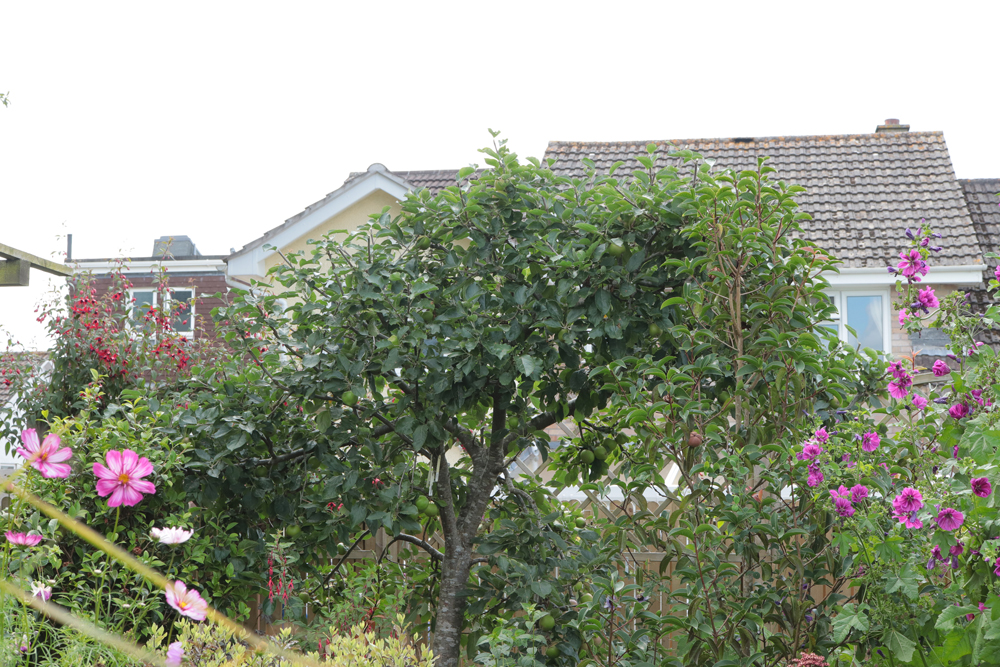
Two.
Eucomis ‘Aloha Kona’. I bought this back in March from Avon Bulbs having grown and liked another in the series, ‘Aloha Leia’ a year or two earlier. It’s quite short but striking. Unlike ‘Aloha Leia’, it doesn’t have a pleasant perfume, in fact it smells rather like Eucomis montana, which is not a good thing, unless you’re a fly sniffing out carrion.
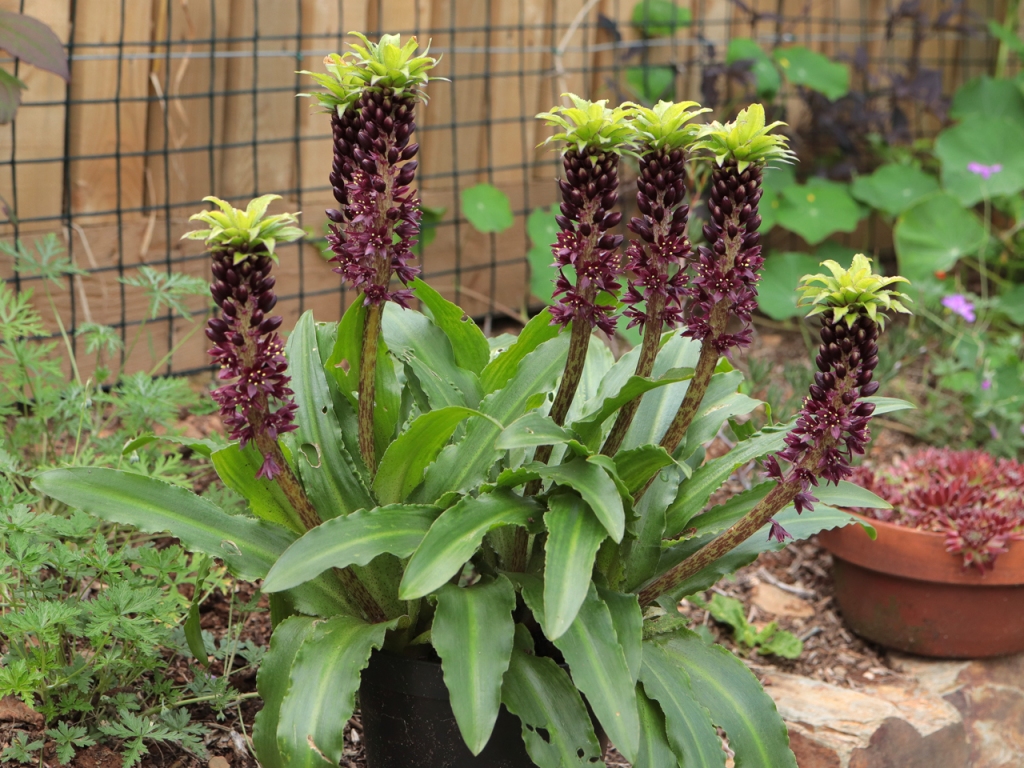
Three.
Allium senescens. I don’t think this did much last year, having been planted autumn 2019. It’s looking very pretty now though and has been flowering for quite a while. There’s an A. senescens subsp glaucum that I shall look out for, or that might tip me over into a small order from Avon Bulbs, who list it. It’s a type of chive, so edible too.
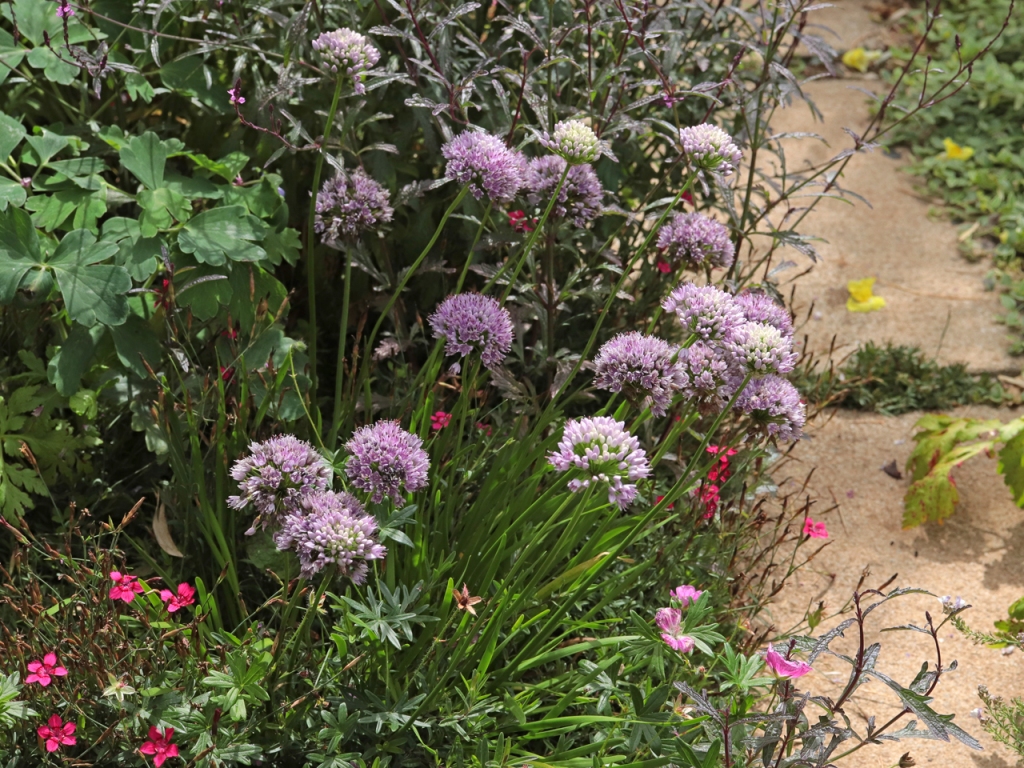
Four.
Sedum telephium. This is a native plant; it grows in some of the lane banks around here, sometimes in quite shady places. It has proved the most successful of the taller sedums for us. ‘Herbstfreude’ is a hybrid between this and S. spectabile. This is tall, 2 feet or more, and a flopper.
Five.
Agapanthus ‘Northern Star’. Good Agapanthus abound but this one still stands out. Dick Fulcher held the National collection for many years and raised a good few hybrids. This was the one he got a PBR on to secure his retirement. Loads of blooms of a very good colour that last well.
Six.
Dianthus ‘Old Blush’. A couple of years back a gardening friend gave us a cutting of a malmaison carnation. At the time it meant nothing to me, I’d heard of them, but knew nothing. I now know that they have an exceptional scent, of cloves. I know that it’s a very old variety, and looking at Allwoods website it looks a very good match for the variety ‘Old Blush’. It dates from pre 1857. And that’s all I know. It’s in a large pot and is thirstier than any other plant I have, so it’s often dry which may be why the flowers haven’t opened fully, or that may be how they always are.
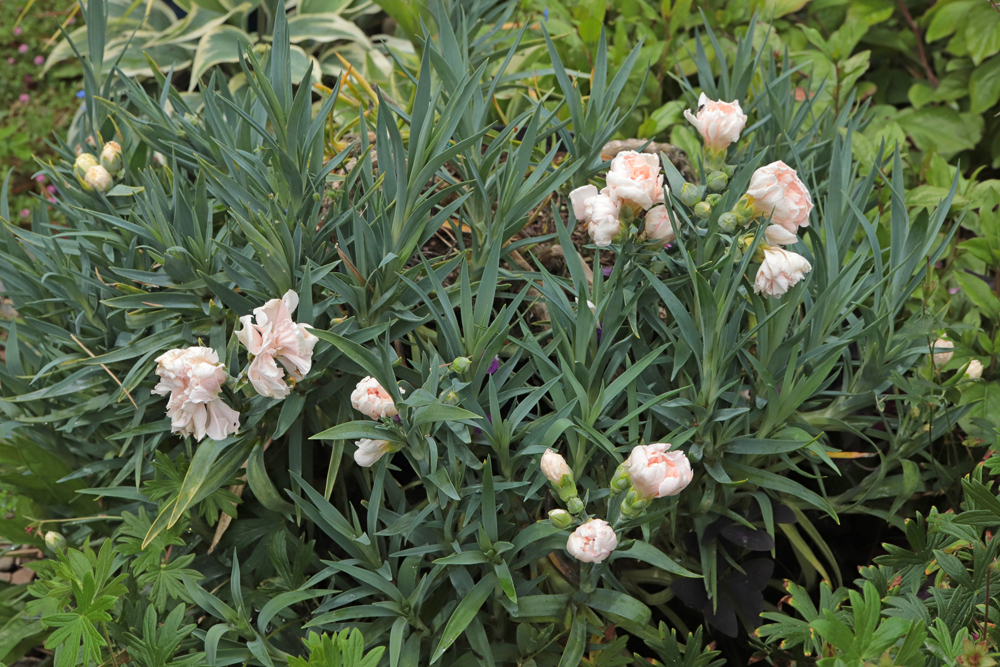
There’s as many again left on the cutting room floor, but that’s how it goes at this time of year. Plenty for visitors to see when we’re open tomorrow, even if it’s starting to get that overblown look. Have a good week.
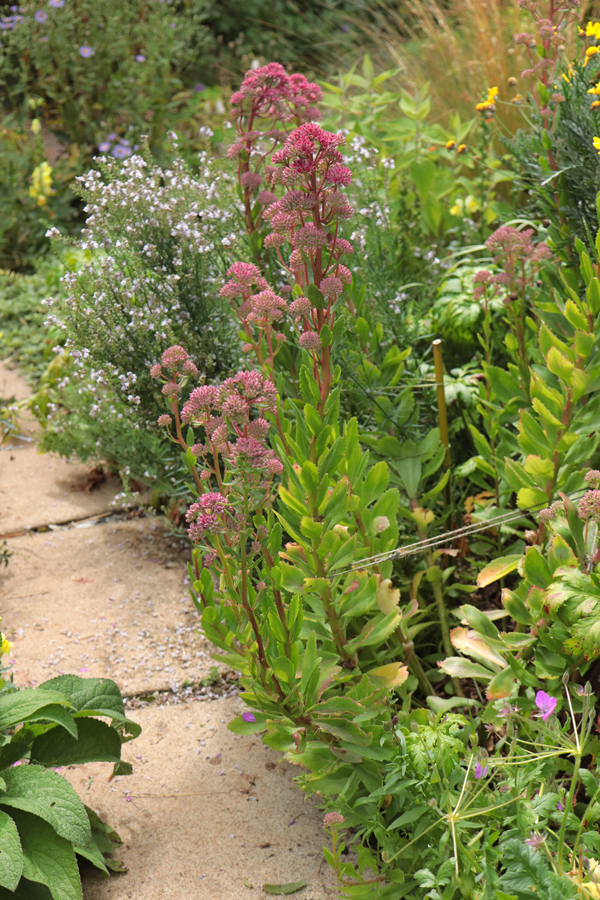


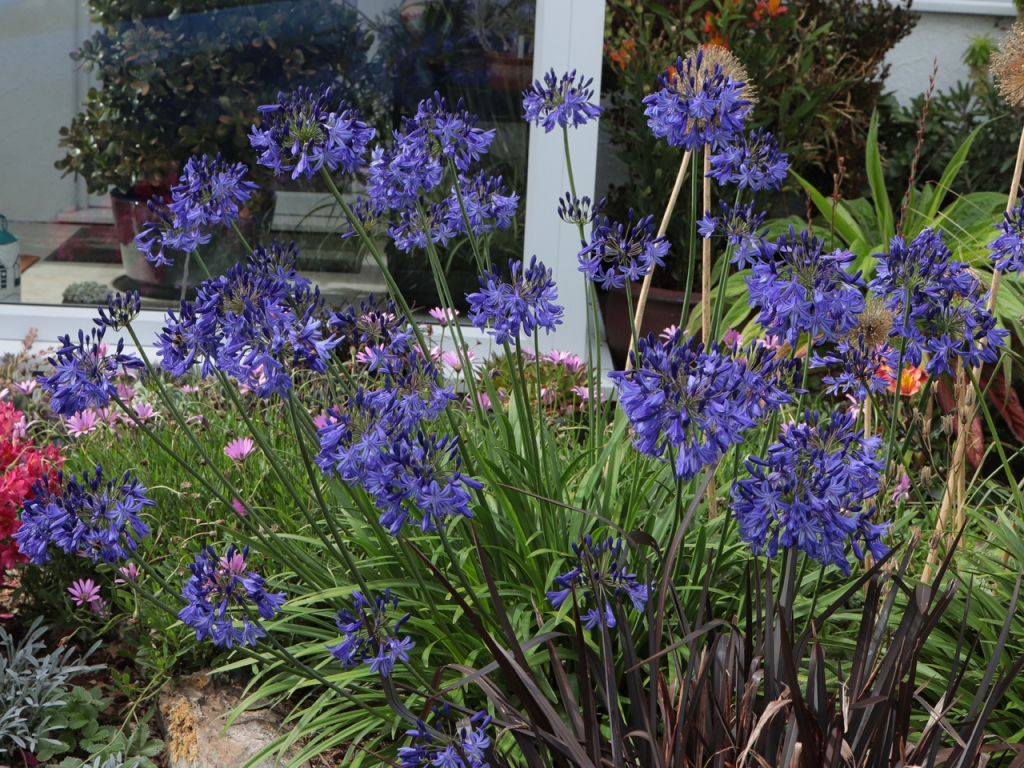

Sedum season is starting here also and some of the apples have put on that secondary growth so I’ll be back to tip them again.
LikeLiked by 1 person
The Agapanthus is a lovely deep blue, really pretty. The Sedum flowers are really pretty too. I’m new to growing Sedum, and bought an Autumn Joy in summer, and I’m pleased to see that it made it through winter! I’m looking forward to seeing it grow and flower in the coming year. If I’m successful in growing it, I will be tempted to try other varieties. One can never tell how the humidity we have will effect the plants. The Eucomis is a beauty, and the malmaison carnations sound lovely too. I had not heard of them before.
LikeLike
Sedums are generally easy and reliable in the UK but down in this corner winter wet can be a problem with some. There are a few native species, so you’d expect them, their varieties and closely related species to be easy. It’s a huge group, there are surely some that will thrive in your conditions.
LikeLiked by 1 person
I’m hoping so.
LikeLiked by 1 person
It’s a shame about the Eucomis smell because it looks stunning, I adore the scent of carnations though so I’m rather envious of your Malmaison.
LikeLike
I think I’d better get some cuttings of the carnation going and try to grow it better. It’s a classy plant.
LikeLike
I like the look of this blog format. Which WordPress theme is it. Just so well suited to photos layout and seems to discipline the eye. You also are a very scientific gardener with precise nomenclature for species. Much to learn here. What do you do with your Agapanthus to keep them looking tidy after the season and when exactly do you start? I am a compulsive seed gatherer and never leave a spent head go into the compost. I also like to speed nature along as in trimming back my peonies, chucking the seed pods right under the plant in hopes something will take there. Keeping the similar plants together so they can be readily identified. I cut the daylily greenery down too and use it as mulch where it is covering it with some compost topping.
LikeLike
The WordPress theme is Floral, appropriately enough. I just spent an hour teasing geranium seeds free from the chaff. I’m not sure why, I have too much of that geranium already. Much the same is true of all the other things I collect seed from. Compulsive, obsessive, something like that. I don’t do much to the Agapanthus, cut off the flower stems and leave the leaves to die down.
LikeLike
Summer pruning of fruit trees still makes me cringe. The Santa Clara Valley used to be famous for orchard production. All pruning was done between from autumn through winter. Nowadays, there is no one left who knows how to prune fruit trees. Horticulturists can not afford to live here. I certainly would not expect anyone who does not understand winter pruning to understand summer pruning, and there is more potential for problems with summer pruning. I still prefer winter pruning for my own trees, and always will. I tell people who want very compact trees that they must learn to perform summer pruning for themselves, because they will not find an arborists who will do it properly for them.
LikeLike
I never quite know where I stand on pruning. I remember someone doing a trial pruning roses by running over them with a hedge trimmer and getting just as good a display as when they were done “properly”. A cider farm near here prunes their orchard by doing a bit of thinning with a chain saw every three years. The UK tends to deal in gardening advice that is skewed towards conditions in the southeast, where the climate is a bit more continental, so I’m used to having to make adjustments for our more maritime conditions. My summer pruning, and grafting on of different varieties, was by way of finding a way to grow apples in a small space and in my conditions. It’s something of an ongoing experiment where I’m probably re-inventing the wheel but at least I’m amusing and educating myself in the process. Almost all commercial apple orchards these days are spindle trees on M9, with a specialized pruning regime. I have tried to grow trees on M9 but without much success. In theory they would be ideal in a small garden; several trees in a small area for pollination, good use of vertical space.
LikeLiked by 1 person
Well, that is precisely why summer pruning became such a fad, particularly in some urban regions. People want to grow fruit in smaller spaces. I will never be comfortable with the ‘smaller spaces’ though. I still miss the last remnants of orchards, and the ‘relatively’ large suburban back yards. I resent the lack of space now. Goodness! I was just in western San Jose yesterday, and the warm and slightly arid weather felt so good! I pulled up some old stepping stones, and the soil below smelled soooooo dirty and awesome! The ground is so perfectly flat! I want a few acres of it, but a 5,000 square foot bit of it costs well over $1.5 million. That is why fruit trees can no longer occupy much space.
LikeLike
Gardens here have become miniscule too, with massive resistance to building on “greenfield” sites, for which read farmland. Farmland however, is only green in the colour sense, from the standpoint of value for wildlife it’s useless. Most urban areas are of greater value so housing with bigger gardens would likely be a gain, not a loss. There’s a lot of nostalgia for old orchards and local apple varieties here and a few orchards/collections have been planted in the last 20-30 years but with the exception of some local cider producers, it doesn’t have commercial legs. Our county, Cornwall, ran something called the Cornwall Orchard Scheme for several years but they were asking people to take on 6 or 7 trees minimum, growing on M25 rootstock which was going to produce a big tree. Very few people would have had room. I have shoots of a couple of old varieties on my home made family tree, an approach that might have made participation possible for a wider range of people. The other thing that appeals to me about summer pruning is that it’s involving. You can’t plant a tree and forget about it. There’s a garden in Sussex called West Dean, who have trained apple trees in myriad different forms and I imagine that it’s much admired by visitors most of whom will regard it as some arcane practice that they couldn’t possibly emulate, which is totally wrong.
LikeLiked by 1 person
Yes, that actually seems to be more common with those who lack experience. So many of my clients install fruit trees as if they just grow and take care of themselves like oleanders or agapanthus, and magically produce fruit without any help. The trees grow like weeds and then collapse from the weight of their own diseased fruit a few years later. Big box stores actually refer to their fruit trees as ‘low maintenance’. It is difficult to watch, especially within the Santa Clara Valley.
LikeLike
Seems to me there’s been a big shift in how people handle knowledge. I’d have done a bit of reading before I bought a tree, learned a bit about needing more than one for pollination, found out a bit about rootstocks and how big the tree might get, thought about how I was going to prune it. Now people seem more likely to buy the tree, then when things don’t go according to plan they look for a YouTube video to find out what to do. It’s treated as if the only knowledge required is how to do something, which can’t be so difficult because look at all these old duffers doing it. Everything becomes so much less interesting when you treat it so superficially so duh! this is boring!
LikeLiked by 1 person
It is frustrating to observe. It applies to so much more than horticulture. I SO miss the functional orchards that lived here for so long and were maintained so well. There are more than a million people here now, and less than a few of them could grow an apricot tree properly. I see how they live though, and it should be no surprise.
LikeLike
There’s too may people in the world and that ain’t a problem you or I are gonna solve. I did my bit and didn’t add to them.
LikeLiked by 1 person
Did that comment go through, and is now waiting for moderation?
LikeLike
Yes.
LikeLiked by 1 person
The dianthus is lovely. Since I moved to NZ I have treated agapanthus as weeds…but they are so lovely!
LikeLike
Agapanthus don’t often self sow here, except in the Isles of Scilly off the south west corner, so they aren’t invasive at the moment. Invasive plants or animals that are showy or cute are a problem everywhere. I need to grow the Dianthus better. I didn’t really expect it to survive so I didn’t give it the attention it warranted. I’ve never killed anything with kindness yet but there’s always a first time.
LikeLike
Again, thanks for the tip on prunning apples, this is much appreciated. I realise now having some secondary growth, I shall have to have a second attempt. I haven’t yet done a prune on my new pear trees, will that be the same?
LikeLike
I’d assume pears would be the same but have no experience with them. Here is the link to the summer pruning information on the RHS site, they lump apples and pears together. I modify their method (do it in two stages) because of secondary growth when done at the time they suggest. https://www.rhs.org.uk/advice/profile?PID=212
LikeLike
I didn’t know what to do tomorrow!… I’m going to prune my apple trees !
Superb Agapanths and very pretty colour of the aeonium which changes with the one I have here. (‘Bicolor’ variety)
LikeLike
I have another apple to prune but I’ll give it another week I think. Aeonium? I think you mean Eucomis. I wonder if I could six of them for next week, they’ve had quite a good year.
LikeLiked by 1 person
Oops, eucomis of course … !
I wrote too quickly : eucomis bicolor is the one I grow
LikeLiked by 1 person